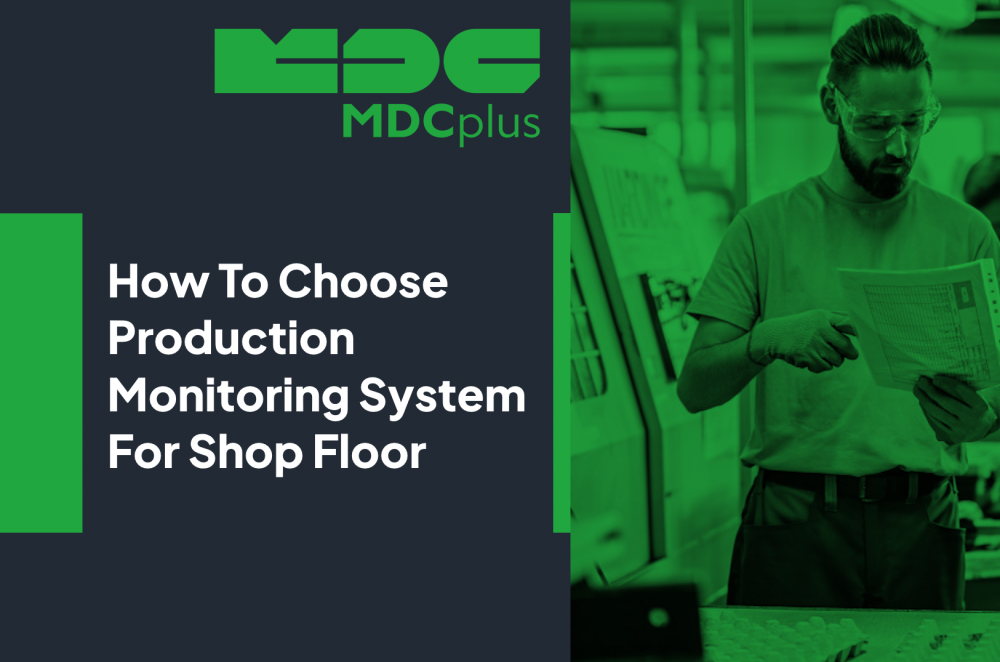No more manufacturing downtimes
Get started with your projectHow to Choose the Right Production Monitoring System for Your Shop Floor
In an era of rising costs, shrinking margins, and complex production demands, real-time visibility on the shop floor is no longer optional - it’s strategic. A well-implemented production monitoring system (PMS) can deliver clarity, control, and confidence in your operations. But with a market flooded with solutions - from low-cost plug-and-play tools to enterprise-scale platforms - how do you choose the right one for your manufacturing environment?
What Is a Production Monitoring System?
At its core, a production monitoring system captures and displays real-time data from machines, operators, and processes, turning raw events into actionable insights. Unlike traditional reporting or manual logs, a PMS works continuously - detecting downtime, tracking cycle times, calculating OEE (Overall Equipment Effectiveness), and exposing bottlenecks without delay.
What It Can Track:
- Machine status (running, idle, alarm, off)
- Production counts and cycle times
- Downtime and its causes
- Operator input and shift performance
- Rejects, scrap, or rework rates
- Energy or asset utilization
The result? Better scheduling, faster response, data-driven improvement, and higher throughput - without guessing.
Why Choosing the Right PMS Matters
The production floor is not a one-size-fits-all environment. What works in a high-volume automotive plant may fall flat in a low-volume job shop. An overbuilt system can be overwhelming and expensive. An underpowered one can fail to deliver value.
A misfit monitoring system can lead to:
- Low adoption by operators and supervisors
- Incomplete or inaccurate data capture
- Inability to integrate with existing systems (like ERP or MES)
- High cost of ownership with low return on investment
The right PMS should enhance - not complicate - your daily operation.
Key Factors to Consider When Choosing a Production Monitoring System
1. Fit for Your Shop Floor Environment
Are you high-mix, low-volume? Or high-volume, repetitive?
Your production profile matters. Systems built for discrete manufacturing may not suit continuous processes. Similarly, CNC-heavy environments may benefit from machine-native integrations, while assembly lines may need operator-based input systems.
Choose a PMS designed for your industry or adaptable to your processes.
2. Data Sources and Connectivity
Can it connect to your existing machines?
A good PMS should support multiple data sources, including:
- PLCs and machine controllers (via OPC UA, MTConnect, etc.)
- I/O modules for older machines
- Manual inputs from operators or barcode scanners
Look for plug-and-play hardware compatibility or proven retrofitting options.
3. Real-Time Dashboards and Alerts
Can the system provide actionable data instantly?
A great system not only captures data but delivers it in real time to those who need it:
- Operators: for immediate feedback on performance
- Supervisors: to detect downtime and assist teams
- Managers: to view KPIs across shifts or departments
Customizable dashboards and mobile alerts are must-haves.
Prioritize intuitive, role-specific interfaces over flashy designs.
4. Ease of Use and Operator Adoption
Will your team actually use it?
The most powerful PMS is useless if it’s ignored on the floor. The system must be:
- Easy to train (minutes, not hours)
- Operator-friendly (simple input methods)
- Clear in how it improves their workflow (not just management oversight)
Run a pilot to evaluate ease of use before full rollout.
5. Scalability and Modularity
Can it grow with you?
Your needs today might be basic - tracking uptime and parts per hour - but next year you may want energy monitoring, predictive maintenance, or AI-driven optimization.
Choose a modular system that lets you scale features without replacing your entire setup.
6. Integration with Other Systems
Does it play well with your ERP, MES, or QMS?
Your PMS should complement - not compete with - existing systems. Look for tools that offer:
- Open APIs
- Pre-built ERP or MES connectors
- Data export options (CSV, JSON, or database sync)
The best systems let your data flow freely - not get trapped in silos.
7. Reporting and Analytics
Can it provide insights, not just information?
Dashboards are great, but decision-makers need:
- Historical trends
- Root cause analysis of downtime
- OEE reports
- Custom KPI tracking
Look for built-in reporting tools or integrations with BI platforms.
8. Support, Training, and Vendor Reliability
Who’s behind the software?
You’re not just buying a product - you’re partnering with a vendor. Look for:
- Proven track record in manufacturing environments
- Responsive customer support (especially during rollout)
- Clear roadmap and ongoing updates
A strong partner today will help you adapt tomorrow.
Questions to Ask Vendors
- How quickly can we start seeing data?
- What types of machines have you successfully integrated?
- Can we start small and expand later?
- Is your system cloud-based, on-premises, or hybrid?
- Do you offer implementation support or onboarding?
Red Flags to Watch Out For
- Overly complex interfaces with no role-based views
- Vendor lock-in with little customization flexibility
- Poor documentation or nonexistent local support
- One-size-fits-all pricing models
- No clear ROI case or reference customers
Make Visibility a Strategic Asset
A production monitoring system isn’t just a software investment - it’s a cultural shift toward data-driven operations. The right system will turn your shop floor from reactive to proactive, from guesswork to precision.
But like any tool, its value depends on the fit. Choose wisely, and you’re not just monitoring production - you’re improving it, every shift, every day.
About MDCplus
Our key features are real-time machine monitoring for swift issue resolution, power consumption tracking to promote sustainability, computerized maintenance management to reduce downtime, and vibration diagnostics for predictive maintenance. MDCplus's solutions are tailored for diverse industries, including aerospace, automotive, precision machining, and heavy industry. By delivering actionable insights and fostering seamless integration, we empower manufacturers to boost Overall Equipment Effectiveness (OEE), reduce operational costs, and achieve sustainable growth along with future planning.
Ready to increase your OEE, get clearer vision of your shop floor, and predict sustainably?
